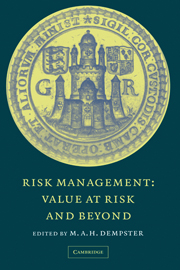Book contents
- Frontmatter
- Contents
- Contributors
- Introduction
- 1 Quantifying the Risks of Trading
- 2 Value at Risk Analysis of a Leveraged Swap
- 3 Stress Testing in a Value at Risk Framework
- 4 Dynamic Portfolio Replication Using Stochastic Programming
- 5 Credit and Interest Rate Risk
- 6 Coherent Measures of Risk
- 7 Correlation and Dependence in Risk Management: Properties and Pitfalls
- 8 Measuring Risk with Extreme Value Theory
- 9 Extremes in Operational Risk Management
7 - Correlation and Dependence in Risk Management: Properties and Pitfalls
Published online by Cambridge University Press: 25 January 2010
- Frontmatter
- Contents
- Contributors
- Introduction
- 1 Quantifying the Risks of Trading
- 2 Value at Risk Analysis of a Leveraged Swap
- 3 Stress Testing in a Value at Risk Framework
- 4 Dynamic Portfolio Replication Using Stochastic Programming
- 5 Credit and Interest Rate Risk
- 6 Coherent Measures of Risk
- 7 Correlation and Dependence in Risk Management: Properties and Pitfalls
- 8 Measuring Risk with Extreme Value Theory
- 9 Extremes in Operational Risk Management
Summary
Abstract
Modern risk management calls for an understanding of stochastic dependence going beyond simple linear correlation. This article deals with the static (nontime- dependent) case and emphasizes the copula representation of dependence for a random vector. Linear correlation is a natural dependence measure for multivariate normally, and more generally, elliptically distributed risks but other dependence concepts like comonotonicity and rank correlation should also be understood by the risk management practitioner. Using counterexamples the falsity of some commonly held views on correlation is demonstrated; in general, these fallacies arise from the naive assumption that dependence properties of the elliptical world also hold in the non-elliptical world. In particular, the problem of finding multivariate models which are consistent with prespecified marginal distributions and correlations is addressed. Pitfalls are highlighted and simulation algorithms avoiding these problems are constructed.
Introduction
Correlation in finance and insurance
In financial theory the notion of correlation is central. The Capital Asset Pricing Model (CAPM) and the Arbitrage Pricing Theory (APT) (Campbell, Lo & MacKinlay 1997) use correlation as a measure of dependence between different financial instruments and employ an elegant theory, which is essentially founded on an assumption of multivariate normally distributed returns, in order to arrive at an optimal portfolio selection. Although insurance has traditionally been built on the assumption of independence and the law of large numbers has governed the determination of premiums, the increasing complexity of insurance and reinsurance products has led recently to increased actuarial interest in the modelling of dependent risks (Wang 1997); an example is the emergence of more intricate multi-line products.
- Type
- Chapter
- Information
- Risk ManagementValue at Risk and Beyond, pp. 176 - 223Publisher: Cambridge University PressPrint publication year: 2002
- 813
- Cited by

